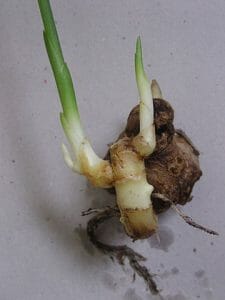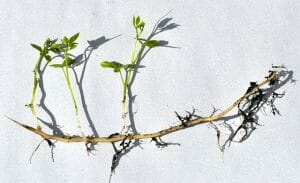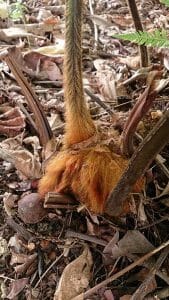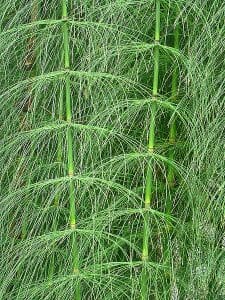Rhizome Definition
A rhizome (also known as rootstocks) is a type of plant stem situated either at the soil surface or underground that contains nodes from which roots and shoots originate (shown below). Rhizomes are unique in that they grow perpendicular, permitting new shoots to grow up out of the ground. When separated, each piece of a rhizome is capable of producing a new plant.
Rhizome Function
The primary function of the rhizome is the storage of nutrients, including carbohydrates and proteins, until the plant requires them for the growth of new shoots or to survive the winter in a process termed vegetative reproduction. Farmers use vegetative reproduction to laterally propagate plants such as hops, ginger and various grass species. Some rhizomes are also consumed or used as a seasoning, including ginger and turmeric.
Rhizome Examples
Underground Rhizomes
By far the most dominant type of rhizome is the underground rhizome (pictured below), which is situated underground and includes ginger, hops, poison oak, grass species, and bamboo. Many of these plants have rhizomes that are consumed by humans (e.g., ginger).
Above-ground Rhizomes
While most rhizomes are situated underground, some plants have rhizomes that grow at the soil level or above (shown below). Examples of these plant species include ferns and irises.
Multi-layered Rhizomes
The majority of rhizomes occur as a single layer from which shoots and roots originate. However, there are some plant species which form multiple layers in a complex network (e.g., Giant Horsetails [shown below]).
Quiz
1. True or False, rhizomes are always found underground.
2. Which of the following statements is TRUE regarding the function of the rhizome:
A. The rhizome is an enzyme found in plants
B. The function of the rhizome is to store nutrients
C. The function of the rhizome is to provide a defense against pathogens
D. None of the above are true
References
- Marba N and Duarte C. (1998). Rhizome elongation and seagrass clonal growth. Marine Ecology Progress Series. 174: 269-280.
- McSteen P. (2009). Hormonal Regulation of Branching in Grasses. Plant Physiology. 149 149 (1) 46-55. DOI: 10.1104/pp.108.129056




